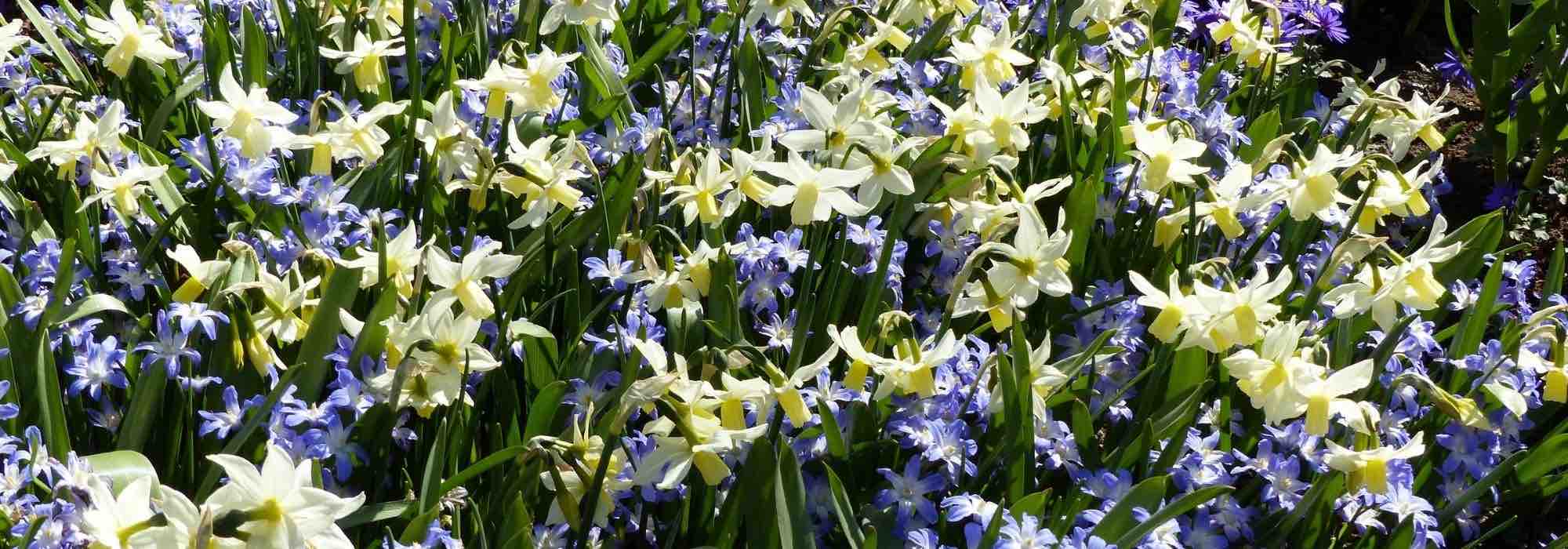
Associating Chionodoxas
Install these little wonders of softness in the garden.
Contents
The Chionodoxas, also known as Glory of the Snow, truly live up to their name as they are among the first to peek through at the end of winter, delighting us with the imminent arrival of spring. Alongside Daffodils, Grape Hyacinths, Snowflakes, and Scillas, with which they share their genus, they enchant us with bright blue carpets for the botanical species. There are also pink and white varieties, and mixing them together is a joy for the eyes.
They naturalise easily in light, cool soil, under gentle sun or partial shade. Native to Asia Minor, they grow naturally at the edges of woodlands or in rocky meadows. They are very hardy, and their fine, deciduous hyacinth-like foliage disappears in summer, reappearing in February or March. Even though these bulbs do not exceed 15 to 20 cm, they hold an important place in the garden as symbols of the awakening earth. Thanks to their small size, they can fit in almost anywhere and establish themselves in many late winter and spring scenes. Easily find them a spot to enjoy the first bulb flowers after winter.
Discover where to plant them in the garden, whether in the ground or in containers and pots, and how to combine them harmoniously.
With spring bulbs
When the sun begins to warm the earth and the snow melts, spring bulbs are the first to emerge from the soil, with our Chionodoxa leading the way, Daffodil, Anemone nemorosa, Muscari, Hyacinth, Botanical Tulip, and Crocus. In February or March, they all appreciate a bit of sunshine to bloom, a light soil that doesn’t suffocate the bulbs, and cool soil to allow for growth.
The Chionodoxa offers a very bright star-shaped flower with a white centre and a gradient of cobalt blue for the botanical species: Chionodoxa lucilae, Chionodoxa forbesii, and Chionodoxa sardensis.
All these small bulbs get along well together. Here, the Chionodoxa forbesii ‘Blue Giant’ is paired with the Tulip clusiana ‘Honky Tonk’, the Daffodil tazetta ‘Avalanche’, the Muscari neglectum, and the Ipheion uniflorum ‘Charlotte Bishop’.

Chionodoxa forbesii ‘Blue Giant’, Tulip clusiana ‘Honky Tonk’, Daffodil tazetta ‘Avalanche’, Muscari neglectum, Ipheion uniflorum ‘Charlotte Bishop’
Read also
Chionodoxas: planting, growing and careIn the border of a flowerbed
At a small height of about 15 cm in flower, Chionodoxa is perfect for the edge of a border, where it joyfully highlights the area. Beneath winter-flowering perennials and bushes, it bridges the gap to the upcoming spring borders.
The Chionodoxa forbesii ‘Pink Giant’, pink and slightly taller as its name suggests, reaching 20 cm in height, is positioned here under a Hamamelis x intermedia ‘Jelena’, alongside Hellebores, Helleborus sternii ‘Remi’ and ‘Grey Star’. Other small bulbs include the snowdrop, Galanthus nivalis and the Eranthis hyemalis with its curious flower shape resting on a collar of finely cut foliage, joining this winter scene.
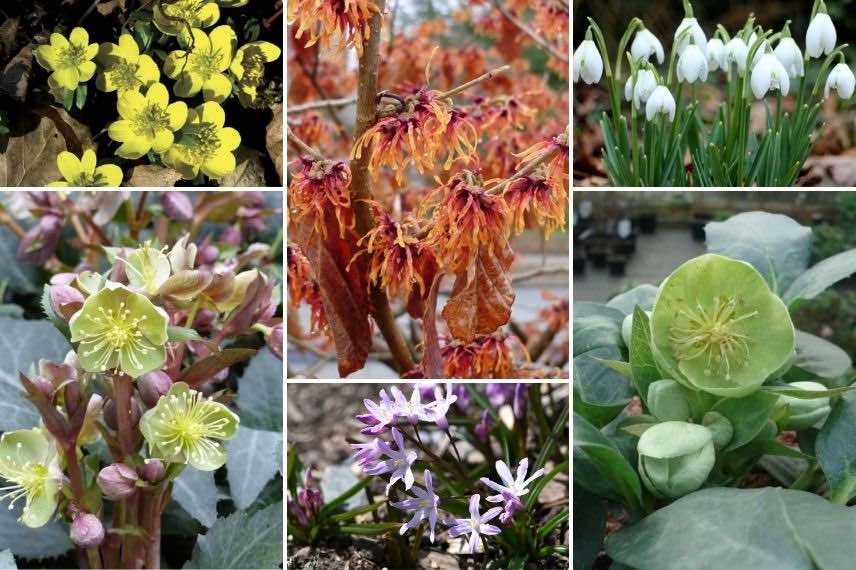
Eranthis hyemalis, Hamamelis x intermedia ‘Jelena’, Galanthus nivalis, Helleborus sternii ‘Remi’, Chionodoxa forbesii ‘Pink Giant’, Helleborus ‘Grey Star’
Discover other Chionodoxa
View all →Available in 1 sizes
Available in 2 sizes
Available in 2 sizes
Available in 1 sizes
Available in 1 sizes
Available in 1 sizes
Available in 1 sizes
Available in 1 sizes
Available in 1 sizes
In carpet
Spring bulb carpets evoke scenes of strolling through woodlands or clearings. Bulbs naturalise all the better when planted in masses; it is under these conditions that you will see them thrive and multiply very quickly. Planted in autumn in a lawn that is not expected to be mown before April or May, they emerge like a surprise under the gentle early spring sun.
Choose to plant pink and white varieties of Chionodoxas, in addition to the blue ones. Add Scillas, close relatives. Vary the shapes and heights for rhythm: botanical Tulips and/or Daffodils and Crocus.
Here, a pastel tableau with mixed Chionodoxas, a Scilla mischtschenkoana ‘Tubergeniana’, a Hyacinth ‘Gipsy Princess’, and a Tulip ‘Lady Jane’.
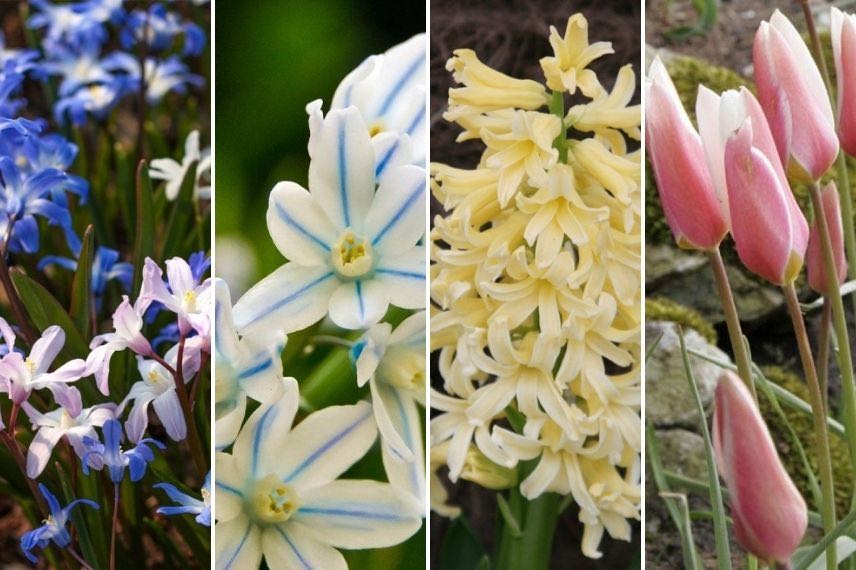
Mixed Chionodoxas, Scilla mischtschenkoana ‘Tubergeniana’, Hyacinth ‘Gipsy Princess’, Tulip ‘Lady Jane’
In rockery
Chionodoxas also have their place in rock gardens, in full sun, in light and cool soil, possibly sandy, provided that the situation is not arid later in the season. Even though the foliage of Chionodoxas will have disappeared by then, the bulbs would suffer in the soil.
Plant them with small succulents like Sedums, alpine plants, and low rosette flowers. Here, the Chionodoxa forbesii ‘Pink Giant’ is alongside a Tulip turkestanica and a Iris reticulata ‘Djit’. A Phlox subbulata ‘Emerald Cushion Blue’ and a Sysirinchium ‘Lucerne’ bloom a little later in the season.
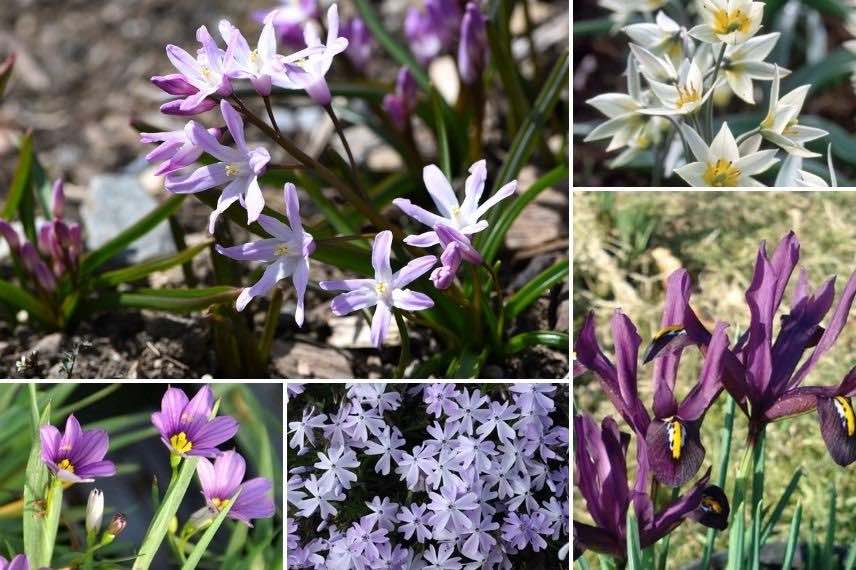
Chionodoxa forbesii ‘Pink Giant’, Tulip turkestanica, Iris reticulata ‘Djit’, Phlox subulata ‘Emerald Cushion Blue’, Sysirinchium ‘Lucerne’
In woodland
Under deciduous trees, Chionodoxa finds the sunlight it needs to flower in February or March and a bit of shade for the rest of the year when it enters dormancy. Its woodland perennial companions also appreciate this situation when temperatures rise.
At the foot of a birch, for example, here a Himalayan white birch, Betula utilis var. jacquemontii ‘Doorenbos’, they harmonise among blue flowers with a very bright Corydalis ‘Craigton Blue’, an Ajuga reptans, a Chionodoxa forbesii ‘Blue Giant’, a Brunnera macrophylla ‘Looking Glass’, and the lovely foliage of a Heuchera ‘Prince of Silver’. Also consider Comfreys, Lamiums, mid-shade Phlox, and Periwinkles.
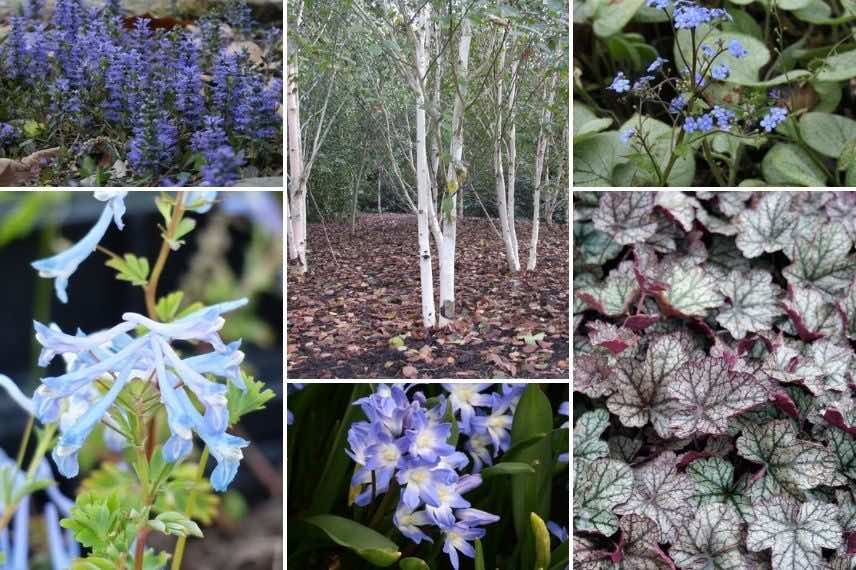
Ajuga reptans, Betula utilis var. jacquemontii ‘Doorenbos’, Brunnera macrophylla ‘Looking Glass’, Heuchera ‘Prince of Silver’, Chionodoxa forbesii ‘Blue Giant’, Corydalis ‘Craigton Blue’
In pairs
With blue flowerings, one might desire a simple contrasting duo with special foliage to highlight it. One might also be tempted by a simple harmony of similar colours.
Here on the left, the Chionodoxa sardensis with a Milium effusum ‘Aureum’ featuring fine, golden foliage. In the middle, a Mukdenia rossii, a lovely perennial with cut foliage that reddens later in the season, and the Chionodoxa luciliae ‘Alba’. On the right, an Ophiopogon planiscapus nigrescens with grass-like foliage so black, and a Chionodoxa forbesii ‘Blue Giant’.

From top to bottom and left to right, contrasting duos or equivalents: Chionodoxa sardensis and Milium effusum ‘Aureum’, Mukdenia rossii and Chionodoxa forbesii ‘Alba’, Ophiopogon nigrescens and Chionodoxa forbesii ‘Blue Giant’
All in white
In a white garden, very bright, at the edge: use the Chionodoxa luciliae ‘Alba’ with its pure white only enhanced by its small yellow stamens, along with the lovely Leucojum vernum (the Spring Snowflake) with its delicate bells, and the aptly named Narcissus poeticus ‘Recurvus’, which blooms a little later, in April-May.

Chionodoxa luciliae ‘Alba’, Narcissus poeticus ‘Recurvus’, Leucojum vernum
Or in blue
As much as white, blue evokes a desire for monochrome. It is a pleasure to observe the shades of colour and the different values of blue.
A Chionodoxa luciliae is here accompanied by Anemone blanda ‘Blue Shades’ and Muscari azureum with light and fresh hues. There are many other shades of Muscari, and also consider other blue spring flowerings: Iris reticulata, Hyacinths, Ipheion, Lithodora diffusa ‘Heavenly Blue’, Veronicas and Geraniums to prolong the flowering.
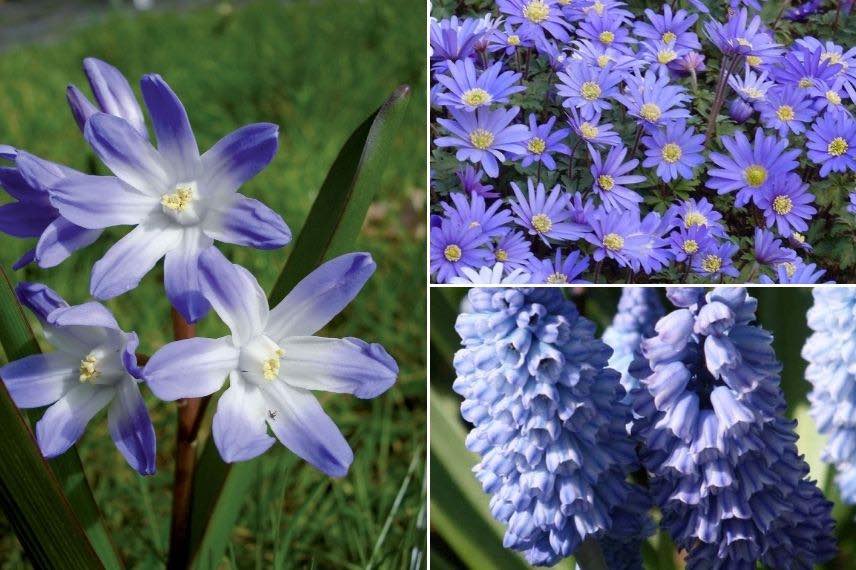
Chionodoxa luciliae, Anemone blanda ‘Blue Shades’, Muscari azureum
In a planter or in a pot
Spring bulbs thrive in containers or pots, allowing for close observation. Their small size invites a closer look. It’s tempting to pair them with some original, rarer, lesser-known bulbs. Plant them in a light, humus-bearing, well-drained substrate. Water regularly to keep it moist. Continue to water lightly once the plants have faded to prevent the substrate from drying out.
Here, we have an Erythronium ‘Pagoda’ with beautifully curved yellow petals, a Puschkinia scilloides ‘Libanotica’ featuring sky-blue star-shaped flowers striped with turquoise, and an Fritillaria meleagris, the Guinea Fowl Fritillary, with its checkered pattern, accompanying the Chionodoxa forbesii ‘Blue Giant’, highlighted by the dark foliage of Heuchera ‘Black Pearl’. Position this arrangement in partial shade, as some of these plants do not tolerate full sun.

Puschkinia scilloides ‘Libanotica’, Heuchera ‘Black Pearl’, Erythronium ‘Pagoda’, Chionodoxa forbesii ‘Blue Giant’, Fritillaria meleagris
For a more classic, colourful composition, plant, for example, Chionodoxa forbesii ‘Violet Beauty’ alongside the lovely Labrador Violet, Viola labradorica, with its highly decorative heart-shaped foliage. Add some Narcissus bulbs: here, the varieties ‘New Baby’ and ‘Tête à Tête’. Also plant a Cyclamen coum ‘Rose’. An ivy, Hedera Helix ‘Shamrock’, adorns the pot with its foliage all year round. Partial shade is also preferred for this arrangement.

Narcissus ‘Tête à Tête’, Viola labradorica, Cyclamen coum ‘Rose’, Narcissus ‘New Baby’, Hedera Helix ‘Shamrock’, Chionodoxa forbesii ‘Violet Beauty’
- Subscribe!
- Contents
































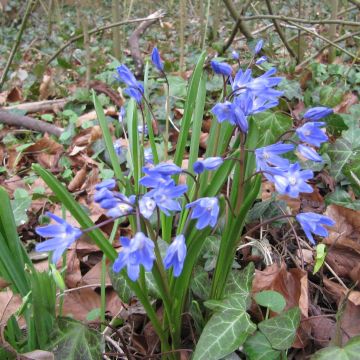
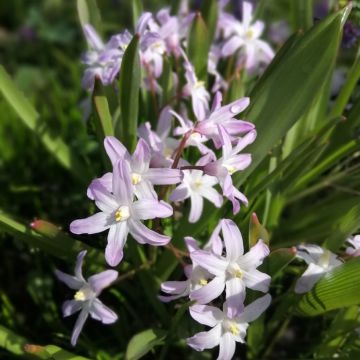
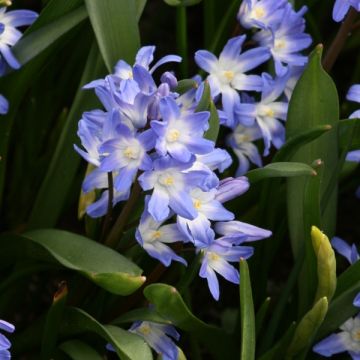


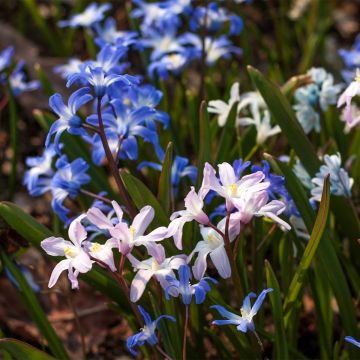
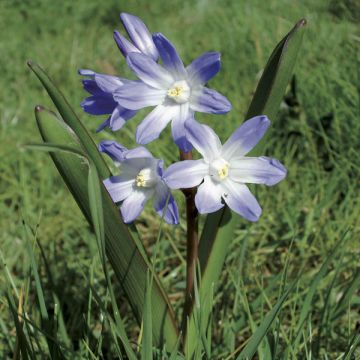


Comments